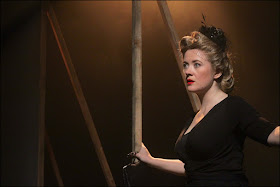“A Fight for Love and Glory”
 The most heart-wrenching moment at this year’s Golden Globes Awards show was the sight of iconic movie star Kirk Douglas trundled on stage in a wheelchair, shriveled, incomprehensible, and incapacitated but still basking in adulation. It was also a powerful reminder that, when Hollywood is involved, it’s still the same old story, a fight for love and glory, even when you’re 101. That no one can deny.
The most heart-wrenching moment at this year’s Golden Globes Awards show was the sight of iconic movie star Kirk Douglas trundled on stage in a wheelchair, shriveled, incomprehensible, and incapacitated but still basking in adulation. It was also a powerful reminder that, when Hollywood is involved, it’s still the same old story, a fight for love and glory, even when you’re 101. That no one can deny. |
| Joanne Harftstone. Photo: Tom Kitney. |
But for all the beautiful, successful people—from actors to hairdressers—applauding the great actor who once played Spartacus and Vincent Van Gogh, history has discarded countless others who either never won such love and glory on the boulevard of broken dreams or who flamed brightly only to be snuffed out tragically like a candle in the wind.
Among the legion of legends surrounding moviedom’s cycle of fame, fortune, and failure is that of Peg Entwistle, a 24-year-old actress who, in 1932, leaped to her death off the “H” in Los Angeles’s famous Hollywoodland (later, just Hollywood) sign on Mount Lee. Hers is the only recorded case of someone thus diving off the sign into the pool of La La history but she’s more the inspiration than the subject of The Girl Who Jumped off the Hollywood Sign, a modestly appealing one-woman play at Theater for the New City. Written by and starring Australian Joanne Hartstone, the work has previously been received positively in international fringe venues and festivals.
 |
| Joanne Hartstone, Photo: Tom Kitney. |
Its fictional subject is 24-year-old actress Evie (short for Evelyn) Edwards. Depressed by her struggles to break into movies, she decides one night in 1949 to emulate Entwistle’s departure. First seen as her hands come into view gripping a vertical edge of the huge H—the upper half of which, supported by slim, wooden trusses, constitutes Tom Kitney’s otherwise bare set—Evie dresses in period regalia of black dress and blond wig, coiffed to suggest a movie star’s “victory rolls” hairdo.
During the ensuing 70 or so minutes Evie—changing her voice and manner for each of the several characters she introduces—describes what led her to this pass. She interlards her autobiographical account with content about not only the Hollywood sign but tidbits about silver screen goddesses Theda Bara, Jean Harlow, Bette Davis, and Judy Garland. It’s fun but film buffs will hear little they don’t already know.
Evie’s personal story comes off as an amalgam of what thousands of similarly inclined women encountered as they sought careers in Hollywood’s dream factory. It covers her close relationship with her widowed father, a tool maker with a gambling habit who was forced to move with her from a comfortable home to a Hooverville shanty when the Depression wiped him out; her music lessons from a boarding house landlady; her dad’s transfer to California when the war broke out; and her subsequent attempt to have a celluloid career there, including a stint working at the “Hollywood Canteen.” The latter segment explains the canteen’s work rules and guest protocols in the show's most interesting history lesson.
 |
| Joanne Hartstone. Photo: Tom Kitney. |
Then there are the auditions, the rejections, the painful notes privileging physical attributes over talent, and even a detour into prostitution before landing a meeting with Jules C. Stein, about whose identity as founder and head of the MCA agency the script neglects to inform us.
During the narrative Evie sometimes breaks into song, offering nostalgic standards—either accompanied by prerecorded instrumentation or a capella—like “Nobody Knows You When You’re Down and Out,” “Blue Moon,” “You Made Me Love You,” and “They’re Writing Songs of Love But Not For Me.” There are as well a couple of less well-known tunes, like “I’m Getting Corns for My Country,” popularized by the Andrews Sisters, and “Every Baby Needs a Da-da-daddy,” originally sung by Marilyn Monroe, who, I only afterward discovered, also wrote its lyrics.
Director Vince Fusco moves Hartstone around nicely, using the crossbar connecting the two legs of the H as a place to sit and stand. Those plywood legs, though, consisting of large, dull panels, practically beg for video and/or still projections to bring 40s Hollywood to Technicolor life.
Clichéd as it is, The Girl Who Jumped off the Hollywood Sign has enough going for it to be appreciated by fans of Hollywood’s Golden Age, and Hartstone brings sincerity and sweetness to her portrayal of Evie. However, the chirpy, high-pitched Midwestern twang she affects, with its frequent upward inflections, is not particularly enthralling. And a quick YouTube check of any of the stars who sang the songs we hear makes immediately clear that if Evie had Hartstone’s pitchy voice, Hollywood wouldn’t have made a major blunder in ignoring her.
Hartstone might have done better to imagine Peg Entwistle’s final moments rather than to concoct a totally new personage, but that would have meant moving the period back to the pre-talkies, a time less well-known to modern audiences. The Girl Who Jumped off the Hollywood Sign seems more intent on reminiscing about the Hollywood of the 1940s than on developing a three-dimensional character we can believe might not only have lived through it but found it necessary to consider jumping.
OTHER VIEWPOINTS:
Theater for the New City
155 First Ave., NYC
Through January 21

